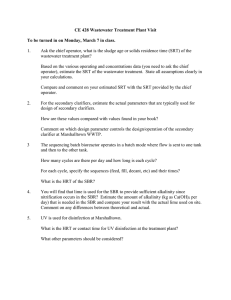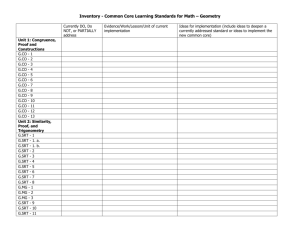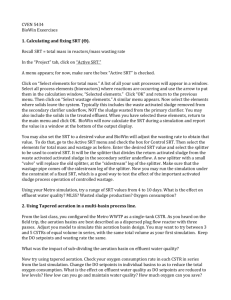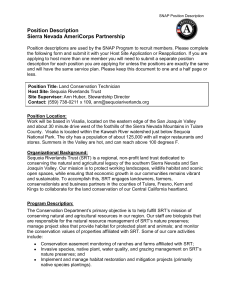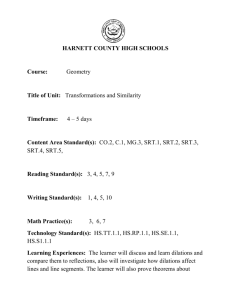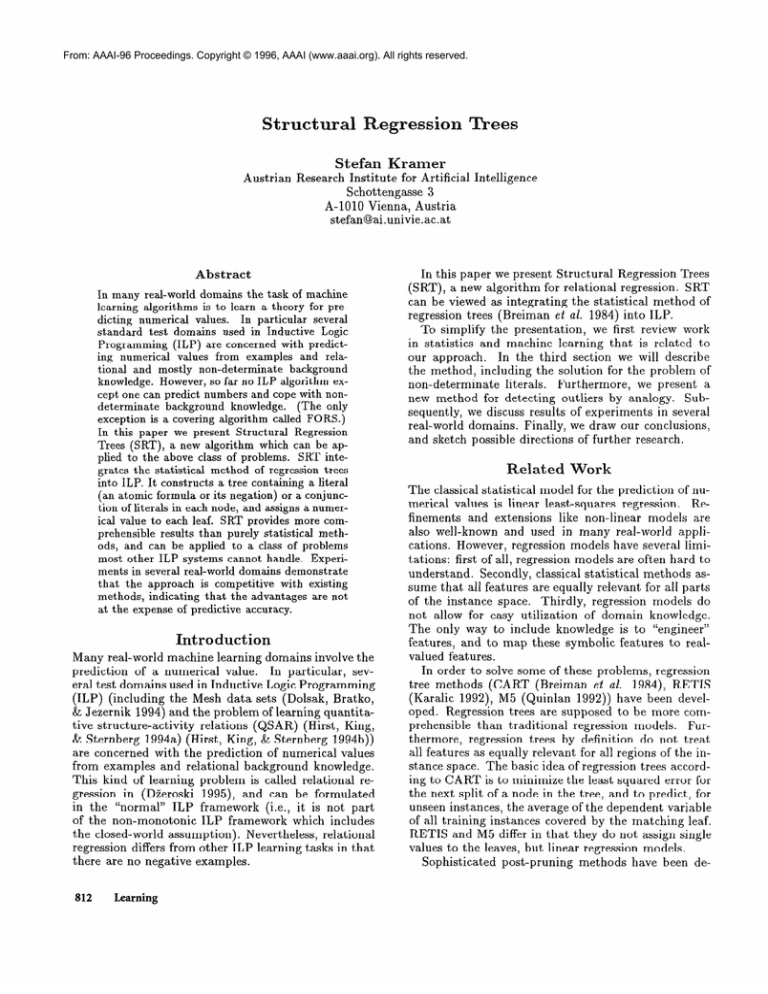
From: AAAI-96 Proceedings. Copyright © 1996, AAAI (www.aaai.org). All rights reserved.
Structural
Stefan Kramer
Austrian
Research Institute for Artificial
Schottengasse 3
A-1010 Vienna, Austria
stefan@ai.univie.ac.at
Abstract
In many real-world domains the task of machine
learning algorithms
is to learn a theory for predicting numerical
values.
In particular
several
standard
test domains
used in Inductive
Logic
Programming
(ILP) are concerned with predicting numerical
values from examples
and relational and mostly non-determinate
background
knowledge.
However, so far no ILP algorithm except one can predict numbers and cope with nondeterminate
background
knowledge.
(The only
exception is a covering algorithm called FORS.)
In this paper we present Structural
Regression
a new algorithm
which can be apTrees (SRT),
plied to the above class of problems.
SRT integrates the statistical
method of regression trees
into ILP. It constructs
a tree containing a literal
(an atomic formula or its negation) or a conjunction of literals in each node, and assigns a numerical value to each leaf. SRT provides more comprehensible results than purely statistical
methods, and can be applied to a class of problems
most other ILP systems cannot handle. Experiments in several real-world domains demonstrate
that the approach
is competitive
with existing
methods, indicating
that the advantages
are not
at the expense of predictive accuracy.
Introduction
Many real-world machine learning domains involve the
prediction of a numerical value.
In particular, several test domains used in Inductive Logic Programming
(ILP) (including the Mesh data sets (Dolsak, Bratko,
& Jezernik 1994) and the problem of learning quantitative structure-activity
relations (QSAR) (Hirst, King,
& Sternberg 1994a) (Hirst, King, & Sternberg 1994b))
are concerned with the prediction of numerical values
from examples and relational background knowledge.
This kind of learning problem is called relational regression in (DBeroski 1995)) and can be formulated
in the “normal” ILP framework (i.e., it is not part
of the non-monotonic
ILP framework
which includes
the closed-world assumption).
Nevertheless, relational
regression differs from other ILP learning tasks in that
there are no negative examples.
812
Learning
Intelligence
In this paper we present Structural Regression Trees
(SRT), a new algorithm for relational regression. SRT
can be viewed as integrating the statistical method of
regression trees (Breiman et al. 1984) into ILP.
To simplify the presentation,
we first review
work
in statistics and machine learning that is related t’o
our approach.
In the third section we will describe
the method,
including
the solution
for the problem
of
non-determinate
literals.
Furthermore,
we present a
new method for detecting outliers by analogy.
Subsequently, we discuss results of experiments in several
real-world domains. Finally, we draw our conclusions,
and sketch possible directions of further research.
elated Work
The classical statistical model for the prediction of numerical values is linear least-squares regression.
Refinements and extensions like non-linear models are
also well-known and used in many real-world applications. However, regression models have several limitations: first of all, regression models are often hard to
understand. Secondly, classical statistical methods assume that, all features are equally relevant for all parts
of the instance space. Thirdly, regression models do
not allow for easy utilization of domain knowledge.
The only way to include knowledge is to “engineer”
features, and to map these symbolic features to realvalued features.
In order to solve some of these problems, regression
tree methods (CART (Breiman et al. 1984), RETIS
(Karalic 1992), M5 (Quinlan 1992)) have been developed. Regression trees are supposed to be more comprehensible than traditional regression models.
Furthermore, regression trees by definition do not t,reat
all features as equally relevant for all regions of the instance space. The basic idea of regression trees according to CART is to minimize the least squared error for
the next split of a node in the tree, and to predict, for
unseen instances, the average of the dependent variable
of all training instances covered by the matching leaf.
RETIS and M5 differ in that they do not assign single
values to the leaves, but linear regression models.
Sophisticated
post-pruning
methods have been de-
veloped for CART, since the method grows the tree
until every leaf is “pure”, i.e. the leaves cover instances
sharing the same value of the dependent variable. The
regression tree resulting from the growing phase is usually bigger than a classification tree, since it takes more
nodes to achieve pure leaves.
Manago’s
KATE
(Manago
1989) learns decision
trees from examples represented in a frame-based language that is equivalent to first-order predicate calculus. KATE makes extensive use of a given hierarchy
and heuristics to generate the branch tests. To our
knowledge, KATE was the first system to induce firstorder theories in a divide-and-conquer
fashion.
Watanabe and Rendell (Watanabe & Rendell 1991)
also investigated
the use of divide-and-conquer
for
learning first-order theories. Although their so-called
structural decision trees are used for the prediction of
categorical classes and not continuous classes, it is the
closest work found in the literature.
So far, two methods have been applied to the problem of relational regression: DINUS/RETIS
(Dzeroski,
Todoroski, & Urbancic 1995), a combination of DINUS
(Lavrac & Dzeroski 1994) and RETIS (Karalic 1992),
and FORS (Karalic 1995).
DINUS/RETIS
transforms
the learning problem
into a propositional
language, and subsequently
applies RETIS,
a propositional
regression tree algorithm, to the transformed
problem.
In contrast to
DINUS/RETIS,
SRT solves the problem in its original representation,
and does not require transforming
Furthermore,
the transformation
does
the problem.
not work for non-determinate
background knowledge,
which is a strict limitation of the appr0ach.i
FORS is the only other algorithm so far that can
be applied to the same class of learning problems as
SRT, since it can also deal with non-determinate
background knowledge.
FORS differs from SRT in its use
of separate-and-conquer
instead of divide-and-conquer
( i.e., it is a covering algorithm, not a tree-based algorithm).
Generally, all the advantages and disadvantages known from other algorithms of these types
(tree-based vs. covering) apply. A discussion of both
strategies in the context of top-down induction of logic
programs can be found in (Bostrom 1995): on the one
hand, the hypothesis space for separate-and-conquer
is
larger than for divide-and-conquer.
Thus, more compact hypotheses might be found using separate-andconquer. On the other hand, building a tree is computationally cheaper than searching for rules. In (Weiss
& Indurkhya 1995), a comparison
of tree induction
and rule induction in propositional regression basically
draws the same conclusions.
However, the approach to
rule-based regression in (Weiss & Indurkhya 1995) is
different from FORS, since it involves the discretization of the numeric dependent variable.
1 Cohen (Cohen 1994b) demonstrated that certain types
of non-determinate background knowledge can be propositionalized. However, this is not generally the case.
A more detailed comparison
between FORS and
SRT shows that FORS may induce clauses containing linear regression models, whereas SRT does not.
Linear regression models usually improve the accuracy
of the induced models, but they also reduce their comprehensibility.
Moreover, FORS requires setting thirteen parameters, whereas SRT only has one parameter. Seven parameters of FORS are used to control
pre-pruning,
whereas SRT uses a simple method for
tree selection based on the minimum description length
(MDL) principle (Rissanen 1978). Most importantly,
we believe that the theories learned by FORS are very
hard to understand, since the rules are basically ordered rule sets (Clark & Boswell 1991): to understand
the meaning of a particular clause, we have t,o understand all preceding clauses in the theory.
c
4
I2
nl
n2
Yl,j
Y&j
set of instances covered by a leaf 1
in a partial tree
the conjunction of all literals in the path
from the root of the tree to E
subset of I for which proving c A t
(t E T, the set of possible tests)
succeeds
subset of I for which proving c A t fails
(I=I1UI2,
I~nI2=0)
number of instances in Ii ( nl = IIll )
number of instances in 12 ( n2 = 1121 )
value of the dependent variable
of a training instance j in 11
value of the dependent variable
of a training instance j in 12
average of all instances in 11
average of all instances in 12
Table 1: Definition
escription
of terms
of the Method
Overview
SRT is an algorithm which learns a theory for t’he prediction of numerical values from examples and relational (and even non-determinate)
background knowledge.
The algorithm constructs a tree cont,aining a
literal (an atomic formula or its negation) or a conjunction of literals in each node, and assigns a numerical
value to each leaf.
More precisely, SRT generates a series of trees of increasing complexity, and subsequently returns one of
the generated trees according to a preference criterion.
This preference criterion is based on the minimum
description
length (MDL) principle (Rissanen 1978))
which helps to avoid overfitting the data especially in
the presence of noise. The whole process can be seen
as a kind of pruning based on the MDL principle.
For the construction of a single tree, SRT uses the
same method as used for the usual top-down inducInductive Learning
813
activity(Drug,8.273)
:-
activity(Drug,6.844)
:-
activity(Drug,6.176)
:-
Table 2: Example
struct(Drug,Groupl,Group2,Group3),
(pi_doner(Group3,X), X< 2).
struct(Drug,Groupl,Group2,Group3),
\+ (pi_doner(Group3,X), X< 2),
h-doner(Groupl,O).
struct(Drug,Groupl,Group2,Group3),
\+ (pi-doner(GroupS,X), X< a),
\+ h-doner(Groupl,O).
of a structural
tion of decision trees (Quinlan 1993a). The algorithm
recursively builds a binary tree, selecting a literal or
a conjunction
of literals (as defined by user-defined
schemata (Silverstein & Pazzani 1991)) in each node
of the tree until a stopping criterion is fulfilled. With
each selected literal or conjunction, the examples covered by a node are further partitioned,
depending on
the success or failure of the literal(s) on the examples.
The selection of the literal or conjunction
is performed as follows: let I be the set of training instances
covered by a leaf I in a partial tree, and c be the conjunction of all literals in the path from the root of the
tree to Z. (For a definition of all used terms see table
1.) Then every possible test t is evaluated according
to the resulting partitioning of the training instances I
in 1. The instances I are partitioned into the instances
11 C I for which proving c A t succeeds, and into the
instances 12 C_ I for which proving CA t fails. For every
possible test t we calculate the sum of the squared differences between the actual values yi,j of the training
instances and the average @ of Ii. From all possible
tests, SRT selects t* E T which minimizes this sum of
squared differences (see equation 1). When the stopping criterion (see below) is fulfilled, the average @ is
assigned to the leaf as the predicted value for unseen
cases that reach the leaf.
Sum
Squared
Errors
= >:
i=l
x(yi,j
_ vii)2
(1)
j=l
From another point of view, each path starting from
the root can be seen as a clause. Every time the tree is
extended by a further literal or conjunction,
two further clauses are generated: one of them is the current
clause (i.e. the path in the current partial tree) extended by the respective literal or conjunction of literals. The other clause is the current clause extended
by the negation of the literal(s). Table 2 shows a simple example of a structural regression tree in clausal
form. The three clauses predict the biological activity
of a compound from its structure and its characteristics. Depending on the conditions in the clauses, the
theory assigns either 8.273 or 6.844 or 6.176 to every
unseen instance. In the following, we will use this latter, clausal view on the process.
The simplest possible stopping criterion is used to
814
Learning
regression tree in clausal form
decide if we should further grow a tree: SRT stops extending a clause when no literal(s) can produce t,wo
further clauses that both cover more than a required
minimum number of training instances. In t,he following this parameter will be called the minimum
coverage of all clauses in the theory. Apart from its use as
a stopping criterion, the minimum coverage parameter
has the following benefits: we have direct control over
the complexity of the trees being built. The smaller the
value of the parameter, the more complex the tree will
be, since we allow for more specific clauses in the t,ree.
In such a way we can generate a series of increasingly
complex trees, and return the one which opt,imizes a
preference function.
Note that if the minimum coverage parameter had a different value, different, split#s
might have been selected in any node of the t’ree.
SRT generates a series of increasingly complex trees
by varying the minimum coverage parameter. The algorithm starts with a high minimum coverage, and
decreases it from iteration to iteration.
Fortunately,
many iterations can be skipped, since nothing would
change for certain values of the minimum coverage parameter: in the process of building the tree, we always
select the one literal or conjunction which produces two
clauses with an admissible coverage and which yields
the lowest sum of squared errors. There could be literals or conjunctions
yielding an even lower sum of
squared errors, but with a coverage that! is too low.
or conjuncThe maximum coverageof these literals
tions is the next value of the paramet,er for which t#he
tree would be different from the current tree. So we
choose this value as the next minimum coverage.
Finally, SRT returns the one tree from this series
that obtains the best compression
of the data. The
compression measure is based on the minimum description length (MDL) p rinciple (Rissanen 1978)) and will
be discussed in the next section.
Tree Selection
by MDL
The MDL principle tries to measure both t’he simplicity
and the accuracy of a particular theory in a common
currency, namely in terms of the number of bits needed
for encoding theory and data. (Cheeseman 1990) defines the message length of a theory (called model in
his article) as:
Total
message length
Message length
to
Message length
to
=
describe
the model
describe
the data,
given the model.
+
This way a more complex theory will need more bits to
be encoded, but might save bits when encoding more
data correctly.
The message length of the model consists of the encoding of the literals and the encoding of the predicted
values in the leaves. The message length of the data,
given the model, is the encoding of the errors.
The encoding of the tree structure is simply the encoding of the choices made (for the respective literals)
as the tree is built. For a single node, we encode the
choice from all possible literals, so that the encoding
considers predicates as well as all possible variabilizations of the predicates.
In addition to the tree structure, we also have to encode the real numbers assigned
to the leaves. In our coding scheme, we turn them into
integers by multiplication
and rounding.
The factor
is the minimum integer that still allows to discern the
values in the training data after rounding.
Then we
encode all these integers in a way that the encoding
requires the same amount of information for all values
regardless of their magnitude.
The errors are also real numbers,
and they are
turned into integers in the same way as above. Subsequently, however, these integers are encoded by the
universal prior of integers (UPI) (Rissanen 1986) - in
this way the coding length of the errors roughly corresponds to their magnitude.
We chose MDL instead of cross-validation
since it is
computationally
less expensive, and it can be used for
pruning in search (Pfahringer & Kramer 1995). However, we are planning to compare both methods for
model selection in the future.
Non-Determinate
Background
Knowledge
Literals are non-determinate
if they introduce new
variables that can be bound in several alternative
Non-determinate
literals often introduce adways.
ditional parts of a structure like adjacent nodes in
a graph.
(Other examples are “part-of”-predicates.)
Clearly, non-determinate
literals do not immediately
reduce the error when they are added to a clause under construction.
Thus, any greedy algorithm without
look-ahead would ignore non-determinate
literals. The
problem is how to introduce non-determinate
literals in
a controlled manner.
In SRT, the user has to specify which literal(s) may
be used to extend a clause. Firstly, the user can define conjunctions of literals that are used for a limited
look-ahead.
(Th ese user-defined schemata are similar
to relational cliches (Silverstein & Pazzani 1991)). Furt,hermore, the user can constrain the set of possible literals depending on the body of the clause so far. The
conditions concerning the body are arbitrary Prolog
clauses, and therefore the user has even more possibilities to define a language than by Antecedent Description Grammars (ADGs)
(Cohen 1994a).
To further
reduce the number of possibilities,
the set of literals
and conjunctions
is also constrained by modes, types
of variables, and variable symmetries.
Outlier
Detection
by Analogy
Test instances that are outliers strongly deteriorate
the average performance of learned regression models.
Usually we cannot detect if test instances are outliers,
because only little information is available for this task.
If relational background knowledge is available, however, a lot of information can be utilized to detect, by
Intuitively,
“analogy” , if test instances are outliers.
when a new prediction is made, we check if the test
instance is similar to the training instances which are
covered by the clause that fires. If the similarity between these training instances and the test instance is
not big enough, we should consider a different prediction than the one suggested by the clause which succeeds on the instance.
In this case, we interpret the
regression tree as defining a hierarchy of clusters. SRT
chooses the cluster which is most similar to the test
instance, and predicts the average of this cluster for
the test instance.
To implement this kind of reasoning by analogy, we
first have to define similarity of “relational structures”
(such as labeled graphs). 2 Our simple approximation
of similarity is based on properties of such structures.
In this context, we say that an instance i has a property P iff P is a literal or a conjunction
(permitted
by specified schemata) that immediately succeeds on i
of interme( i.e., it succeeds without the introduction
diate variables).
The similarity is defined as follows:
let pinstance
denote th e set of properties of an instance i. Let pinVeommon(I) be the set of properties all
instances in a set I have in common.
Then the similarity between a test instance i and a set (cluster) of
training instances I is
similarity(i,
I) =
lPi7hZ?lC~ (i) n ~~~~~~~~~~ (1) I
IPin-common (1) I
The similarity is simply defined as the number of properties that the test instance and the covered training
instances have in common, divided by the number of
properties that the training instances have in common.
SRT uses a parameter for the minimum
similarity
to determine if the similarity between a test instance
and the training instances covered by the clause that
fires is large enough.
The minimum
similarity
parameter is the only real parameter of SRT, since the
best value for the required minimum
coverage
of a
clause is determined
automatically
using the MDL
2(Bisson 1992) defined a similarity measure for firstorder logic, but it measures the similarity of two tuples
in a relation, not of two “relational structures”.
Inductive Learning
815
Pyrimidines
Method
Linear Regression on Hansch parameters and squares
Linear Regression on attributes and squares
Neural Network on Hansch parameters and squares
Neural Network on attributes and squares
GOLEM
SRT
Table 3: Summary of all methods in the biomolecular
pyrimidines and by triazines: performances as measured
principle.
Note that although we choose the cluster
with the largest similarity, this similarity might be
smaller than the specified minimum
similarity.
This way of detecting and handling outliers adds an
instance-based
aspect to SRT. However, it is just an
additional possibility, and can be turned off by means
of the minimum similarity parameter.
Experimental
Results
We performed experiments in five real-world domains.
For each domain,
we performed
experiments
with
(minimum
similarity
= 0.75 ) and without outlier
detection by analogy (minimum
similarity
= 0 ). In
cases where outlier detection affects the results, we will
mention it in the discussion.
A common step in pharmaceutical
development is
forming a quantitative
structure-activity
relationship
(QSAR) th a t re 1a t es the structure of a compound to
its biological
activity.
Two QSAR domains, namely
the inhibition of Escherichia
coli dihydrofolate reductase (DHFR)
by pyrimidines
(Hirst, King, & Sternberg 1994a) and by triazines (Hirst, King, & Sternberg
199413) have been used to test SRT.
The pyrimidine dataset consists of 2198 background
facts and 55 instances (compounds),
which are partitioned into 5 cross-validation
sets. For the triazines,
the background knowledge are 2933 facts, and 186 instances (compounds)
are used to perform 6-fold cross
validation.
Hirst et al. made comprehensive
comparisons of several methods in these domains, but they
concluded there is no statistically significant difference
between these methods.
Table 3 shows the results of the methods compared
in (Hirst, King, & Sternberg 1994a) and in (Hirst,
King, & Sternberg 1994b), and the results of SRT. The
table summarizes the test set performances in both domains as measured by the Spearman rank correlation
coefficients. The Spearman rank correlation coefficient
is a measure of how much the order of the test instances
according to the target variable correlates with the order predicted by the induced theory. The only reason
why Hirst et al. use the Spearman rank correlation
coefficient instead of, say, the average error is to compare GOLEM (Muggleton & Feng 1992) (which cannot
816
Learning
0.693
0.654
0.677
0.660
0.692
0.806
Mean (a)
(0.170)
(0.104)
(0.118)
(0.225)
(0.077)
(0.110)
Triazines
0.272
0.446
0.377
0.481
0.431
0.457
Mean (a)
(0.220)
(0.181)
(0.190)
(0.145)
(0.166)
(0.089)
domains of the inhibition of dihydrofolate
reductase
by the Spearman rank correlation coefficients
by
predict numbers) with other methods.3
For the pyrimidines, SRT performs better than other
methods, but the improvement is not statistically sigemphasize that a difference
nificant.
Hirst et al.
in Spearman rank correlation coefficient of about 0.2
would have been required for a data set of this size.
The comparatively good performance of SRT is mostly
due to the detection of two outliers that cannot be recognized by other methods. These two outliers were the
only ones identified in these two domains. For the triazine dataset, SRT performs quite well, but again the
differences are not statistically significant.
Since the Spearman rank correlation coefficient does
not measure the quantitative error of a prediction, we
included several other measures as proposed by Quinlan (Quinlan 199313). Clearly, these measures have disadvantages, too, but they represent interesting aspects
of how well a theory works for a given test set. Unfortunately, we do not yet have a full comparison with other
methods that are capable of predicting numbers. Tables 4 and 7 contain the cross-validation test set performances of SRT in four test domains not only in terms
of the Spearman rank correlation coefficient, but also
in terms of several other accuracy measures.
Furthermore, we performed experiments in the domain of finite element mesh design (for details see
(Dolsak, Bratko, & Jezernik 1994)), where the background knowledge is non-determinate.
Table 5 shows
the results of SRT for the mesh dataset together with
the results of FOSSIL (Fiirnkranz 1994) and results of
other methods that were directly taken from (Karalic
1995). SRT performs better than FOIL (Quinlan 1990)
and mFOIL (Dzeroski & Bratko 1992), but, worse than
the other methods. However, statistical analysis shows
that only the differences between FOIL and the other
algorithms are significant.
We also applied SRT to the biological problem of
learning to predict the mutagenic activity of a chemical, i.e., if it is harmful to DNA. (For details see
(Srinivasan et al. 1994) and (Srinivasan, Muggleton,
& King 1995)). Th is d omain involves non-determinate
background knowledge, too. In Table 6 we compiled
3Despite this disadvantage of GOLEM, Hirst et al. state
that GOLEM is the only method that provides understandable rules about drug-receptor
interactions.
SRT can be
seen as a step towards integrating
both capabilities.
Pyr. Mean (a)
Measure of Accuracy
Spearman rank correlation
Average error IEI
Correlation r
Relative Error RE
Table 4: Performances
1 Struct.
coefficient
(0.110)
(0.088)
(0.091)
(0.170)
of SRT in three domains
11 FOIL
1 mFOIL
c
36
%
12.9
62
22.3
Table 5: Results of several methods
correctly classified edges
0.806
0.435
0.818
0.218
1 GOLEM
Triaz.
,
Mean (g)
0.457
0.514
0.457
0.381
Mutagen.
0.683
1.103
0.736
0.170
in terms of several accuracy
1 MILP
I FOSSIL
80
90
90
28.8
32.4
32.4
in the domain
(0.089)
(0.084)
(0.104)
(0.132)
of finite element
measures
I FORS
1 SRT
87
31.3
68
24.4
mesh design:
Mean (0)
(0.124)
(0.121)
(0.089)
(0.055)
1
numbers
and percentages
of
results from (Karalic 1995) and (Srinivasan, Muggleton, & King 1995), and filled the result of SRT. In the
table, ‘S’ refers to structural background knowledge,
‘NS’ refers to non-structural
features, ‘PS’ refers to
predefined structural features that can be utilized by
propositional
algorithms,
and ‘MDL’ refers to MDL
pre-pruning.
(Note that the results of FORS are the
best that can be found by varying three of its parameters.) In the experiments we used the 188 instances
(compounds)
for a lo-fold cross-validation.
The accuracy concerns the problem to predict if a chemical is
active or not. Since SRT learns a theory that predicts
the activity (a number) instead, we had to evaluate it
in a different way (by discretization) to compare the results. Summing up, the experiments showed that SRT
is competitive in this domain too, although the differences between SRT and the rest are not statistically
significant.
quantitatively
competitive,
but its main advantages
are that it yields comprehensible
and explicit rules for
predicting numbers, even when given non-determinate
background knowledge.
Finally, we applied SRT to a domain where we are
trying to predict the half-rate of surface water aerobic
aqueous biodegradation
in hours (DBeroski & Kompare
1995).
To simplify the learning task, we discretized
this quantity and mapped it to {1,2,3,4}.
The background knowledge is non-determinate,
and except for
the molecular weight there are no “global” features
available. The dataset contains 62 chemicals, and we
performed 6-fold cross-validation
in our tests. The results of SRT can be found in table 7. SRT is the first
algorithm to be tested on the data, and the results appear to indicate that there are too few instances to find
Again, SRT with outlier detecgood generalizations.
tion improves upon the result of SRT without it. Note
that neither a propositional algorithm (such as CART)
nor an algorithm that cannot handle non-determinate
background
knowledge (such as FOIL, GOLEM and
can be applied to this problem.
DINUS/RETIS)
Table 6: Summary of accuracy
the mutagenicity domain
To sum up the experiments,
SRT turned out to be
1 CART + NS
FOIL + NS + S
Progol + NS + S
FORS + NS + S
FORS + NS + S + MDL
SRT + NS + S
Conclusion
and
I
) 0.82
0.81
0.88
0.89
0.84
0.85
(0.03j 1
(0.03j
(0.02)
(0.06)
(0.11 j
(0.08)
of several systems
rther
in
esearch
In this paper we presented Structural Regression Trees
(SRT), a new algorithm which can be applied to learning problems concerned with the prediction of numbers
from examples and relational (and non-determinate)
SRT can be viewed as inbackground
knowledge.
tegrating the statistical
method of regression trees
(Breiman et al. 1984) into ILP. SRT can be applied
to a class of problems no ILP system except FORS
can handle, and learns theories that may be easier t,o
understand than theories found by FORS (section 2).
The advantages and disadvantages of SRT are basically
the same as the ones of CART: regression trees have
a great potential to be explanatory, but we cannot expect to achieve a very high accuracy, since we predict
Inductive Learning
817
Biod.
Measure of Accuracy
Spearman rank correlation
Average error IEI
Correlation r
Relative Error RE
Table 7: Performances
coefficient
with Outl.
0.463
0.744
0.382
0.363
of SRT with and without
constant values for whole regions of the instance space.
As it could help to build more accurate models, one of
the next steps will be to assign linear regression models
to the leaves.
One of the biggest differences between SRT and
FORS is that it is a tree-based and not a covering algorithm. So generally all the advantages and disadvantages known from other algorithms of these types apply (Bostrijm 1995) (Weiss & Indurkhya 1995). However, FORS and SRT also differ in many other ways,
and thus a real comparison of the search strategies employed is still to be done for relational regression.
Experiments
in several real-world domains demonstrate that the approach is competitive with existing
methods, indicating that its advantages (the applicability to relational regression given non-determinate
background
knowledge and the comprehensibility
of
the rules) are not at the expense of predictive accuracy.
SRT generates a series of increasingly complex trees,
but currently every iteration starts from scratch. We
are planning to extend the algorithm such that parts
of the tree of one iteration can be reused in the next
iteration.
We also plan to compare our way of coverage-based
prepruning and tree selection by MDL with more traditional pruning methods a la CART (Breiman et al.
1984).
Besides,
we addressed
the
problem
of nondeterminate literals. We adopted and generalized solutions for this problem, but they involve the tiresome
task of writing a new specification of admissible literals
and conjunctions for each domain. We therefore think
that a more generic solution would make the application of the method easier.
Acknowledgements
This research is sponsored by the Austrian Fonds zur
Forderung
der Wissenschaftlichen
Forschung
(F WF)
under grant number P10489-MAT.
Financial support
for the Austrian Research Institute for Artificial Intelligence is provided by the Austrian Federal Ministry
of Science, Research, and Arts. I would like to thank
Johannes Fiirnkranz, Bernhard Pfahringer and Gerhard Widmer for valuable discussions.
I also wish to
thank Saso Dzeroski for providing the biodegradability dataset and the anonymous AAAI referees for their
comments which helped to improve this paper.
818
Learning
Det. Mean ((T)
Biod.
w o Outl.
(0.213)
(0.190)
(0.247)
(0.139)
outlier detection
0.402
0.771
0.364
0.377
Det.
Mean
~7
7
(0.232)
(0.210)
(0.223)
(0.141)
in the biodegradability
domain
References
Bisson, G. 1992. Learning in FOL with a similarity measure. In Proc. Tenth National Conference
on
Artificial Intelligence
(AAAI-92).
Bostrom, H. 1995. Covering vs. Divide-and-Conquer
for Top-Down
Induction of logic programs.
In Proc.
Fourteenth International
Joint Conference
on Artijicial Intelligence
(IJCAI-95),
1194-1200.
San Mateo,
CA: Morgan Kaufmann.
Breiman, L.; Friedman, J.; Olshen, R.; and Stone,
C. 1984. Classification
and Regression
Trees. The
Wadsworth
Statistics/Probability
Series. Belmont,
CA: Wadsworth International Group.
Cheeseman, P. 1990. On finding the most probable
model. In Shrager, J., and Langley, P., eds., Computational Models of Discovery and Theory Formation.
Los Altos, CA: Morgan Kaufmann.
Clark, P., and Boswell, R.
1991.
Rule induction
with CN2: Some recent improvements. In Proceedings
of the Fifth European
Working Session on Learning,
151-161. Berlin Heidelberg New York: Springer.
Cohen, W. 1994a. Grammatically
biased learning:
Learning logic programs using an explicit antecedent
description language. Artificial Intelligence 68(2).
Pat-learning
nondeterminate
Cohen, W.
1994b.
clauses. In Proc. Twelfth National Conference
on Artificial Intelligence
(AAAI-94).
Dolsak, B.; Bratko, I.; and Jezernik, A. 1994. Finite element mesh design: An engineering domain for
ILP application.
In Proceedings of the Fourth International Workshop on Inductive Logic Programming
GMD-Studien
Nr. 237, 305-320.
(ILP-94),
Dieroski, S., and Bratko, I. 1992. Handling noise in
Inductive Logic Programming.
In Proceedings of the
International
Workshop on Inductive Logic Programming.
Dzeroski, S., and Kompare,
munication.
B. 1995.
Personal
Com-
Dzeroski, S.; Todoroski, L.; and Urbancic, T. 1995.
Handling real numbers in inductive logic programming: A step towards better behavioural clones. In
Lavrac, N., and Wrobel, S., eds., Machine Learning:
ECML-95,
283-286.
Berlin Heidelberg New York:
Springer.
Dzeroski, S. 1995. Numerical Constraints and Learnability in Inductive Logic Programming.
Ph.D. Dissertation, University of Ljubljana, Ljubljana, Slovenija.
Fiirnkranz, J.
1994.
FOSSIL: A robust relational
learner. In Bergadano, F., and De Raedt, L., eds.,
Machine Learning:
ECML-94, 122-137.
Berlin Heidelberg New York: Springer.
Hirst, J.; King, R.; and Sternberg, M. 1994a. Quantitative structure-activity
relationships by neural networks and inductive logic programming.
the inhibition of dihydrofolate reductase by pyrimidines.
Journal of Computer-Aided
Molecular Design 8:405-420.
Hirst, J.; King, R.; and Sternberg, M. 199413. Quantitative structure-activity
relationships by neural networks and inductive logic programming:
The inhibition of dihydrofolate
reductase by triazines. Journal
of Computer-Aided
Molecular Design 81421-432.
1992.
Employing
linear regression in
Karalic, A.
regression tree leaves. In Neumann, B., ed., Proc.
Tenth European Conference
on Artificial Intelligence
(ECAI-92),
440-441. Chichester, UK: Wiley.
Karalic, A.
Dissertation,
Slovenij a.
First
1995.
University
Lavrac, N., and Dieroski,
Programming.
Chichester,
Order Regression.
Ph.D.
of Ljubljana,
Ljubljana,
S. 1994. Inductive
UK: Ellis Horwood.
Srinivasan, A.; Muggleton, S.; King, R.; and Sternberg, M. 1994. Mutagenesis:
ILP experiments
in
a non-determinate
biological domain. In Proceedings
of the Fourth International
Workshop on Inductive
Logic Programming
(ILP-94),
GMD-Studien
Nr. 237,
217-232.
Srinivasan, A.; Muggleton, S.; and King, R. 1995.
Comparing the use of background knowledge by Inductive Logic Programming systems. In Proceedings
of the 5th International
Workshop on Inductive Logic
Programming
(ILP-95),
199-230. Katholieke Universiteit Leuven.
Watanabe, L., and Rendell, L. 1991. Learning structural decision trees from examples. In Proc. Twelfth
International
Joint Conference
on Artificial Intelligence (IJCAI-9l),
770-776. San Mateo, CA: Morgan
Kaufmann.
Weiss, S., and Indurkhya,
N.
1995.
Rule-based
machine learning methods for functional prediction.
Journal of Artificial Intelligence
Research 3:383-403.
Logic
Manago, M. 1989. Knowledge-intensive
induction. In
Segre, A., ed., Proceedings of the Sixth International
Workshop on Machine
Learning,
151-155.
Morgan
Kaufman.
Muggleton, S., and Feng, C. 1992. Efficient induction
of logic programs.
In Muggleton,
S., ed., Inductive
Logic Programming.
London, U.K.: Academic Press.
281-298.
Pfahringer , B . , and Kramer, S. 1995. Compressionbased evaluation of partial determinations.
In Proceedings of the First International
Conference
on
Knowledge Discovery and Data Mining. AAAI Press.
Quinlan, J. 1990.
relations. Machine
Learning logical definitions
Learning 5:239-266.
from
Quinlan, J. 1992. Learning with continuous classes.
In Adams, S., ed., Proceedings AI’92, 343-348.
Singapore: World Scientific.
Quinlan,
Learning.
J.
1993a.
San Mateo,
C4.5:
Programs for Machine
CA: Morgan Kaufmann.
Quinlan, J. 199313. A case study in machine learning.
In Proceedings ACSC-16
Sixteenth Australian Computer Science Conference.
Rissanen, J. 1978. Modeling by shortest data description. Automatica 14:465-471.
Rissanen, J. 1986. Stochastic
ing. The Annals of Statistics
complexity and model14(3):1080-1100.
Silverstein, G., and Pazzani, M.
1991. Relational
cliches: Constraining
constructive
induction during
relational learning. In Birnbaum, L., and Collins, G.,
eds., Machine Learning:
Proceedings of the Eighth International
Workshop (ML91), 203-207.
San Mateo,
CA: Morgan Kaufmann.
Knowledge Bases
819


